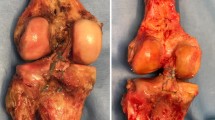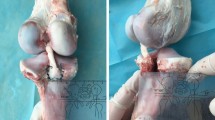Abstract
Purpose
The most common fixation techniques for tibial avulsion fractures of the anterior cruciate ligament (ACL) described in the literature are screw and suture fixation. The fixation of these fractures with the TightRope® device might be an alternative. Up to now it has been commonly used in other injuries, such as acromioclavicular joint or syndesmosis ruptures. The purpose of this study was to evaluate the biomechanical properties of different fixation techniques for the reconstruction of tibial avulsion fractures.
Methods
Type III tibial avulsion fractures were simulated in 40 porcine knees. Each specimen was randomly assigned to one of four groups: (1) anterograde screw fixation, (2) suture fixation, (3) TightRope® fixation or (4) control group. The initial displacement, strength to failure and the failure mode were documented.
Results
The maximum load to failure was 1,345 ± 155.5 N for the control group, 402.5 ± 117.6 N for the TightRope® group, 367 ± 115.8 N for the suture group and 311.7 ± 120.3 N for the screw group. The maximum load to failure of the control group was significantly larger compared to all other groups. The initial dislocation was 0.28 ± 0.09 mm for the control group, 0.55 ± 0.26 mm for the TightRope® group, 0.84 ± 0.15 mm for the screw group and 1.14 ± 0.9 mm for the suture group. The initial dislocation was significantly larger for the suture group compared to the TightRope® and control groups.
Conclusions
The TightRope® fixation shows significantly lower initial displacement compared to the suture group. The TightRope® fixation might be an alternative for the repair of ACL tibial avulsion fractures that can be used arthroscopically.



Similar content being viewed by others
References
Ahn JH, Yoo JC (2005) Clinical outcome of arthroscopic reduction and suture for displaced acute and chronic tibial spine fractures. Knee Surg Sports Traumatol Arthrosc 13(2):116–121
Griffith JF, Antonio GE, Tong CW, Ming CK (2004) Cruciate ligament avulsion fractures. Arthroscopy 20(8):803–812
Hunter RE, Willis JA (2004) Arthroscopic fixation of avulsion fractures of the tibial eminence: technique and outcome. Arthroscopy 20(2):113–121
Huang TW, Hsu KY, Cheng CY, Chen LH, Wang CJ, Chan YS, Chen WJ (2008) Arthroscopic suture fixation of tibial eminence avulsion fractures. Arthroscopy 24(11):1232–1238
Kogan MG, Marks P, Amendola A (1997) Technique for arthroscopic suture fixation of displaced tibial intercondylar eminence fractures. Arthroscopy 13(3):301–306
Ahn JH, Lee YS, Lee DH, Ha HC (2008) Arthroscopic physeal sparing all inside repair of the tibial avulsion fracture in the anterior cruciate ligament: technical note. Arch Orthop Trauma Surg 128(11):1309–1312
Delcogliano A, Chiossi S, Caporaso A, Menghi A, Rinonapoli G (2003) Tibial intercondylar eminence fractures in adults: arthroscopic treatment. Knee Surg Sports Traumatol Arthrosc 11(4):255–259
Kim YM, Kim SJ, Yang JY, Kim KC (2007) Pullout reattachment of tibial avulsion fractures of the anterior cruciate ligament: a firm, effective suture-tying method using a tensioner. Knee Surg Sports Traumatol Arthrosc 15(7):847–850
Lafrance RM, Giordano B, Goldblatt J, Voloshin I, Maloney M (2010) Pediatric tibial eminence fractures: evaluation and management. J Am Acad Orthop Surg 18(7):395–405
Bong MR, Romero A, Kubiak E, Iesaka K, Heywood CS, Kummer F, Rosen J, Jazrawi L (2005) Suture versus screw fixation of displaced tibial eminence fractures: a biomechanical comparison. Arthroscopy 21(10):1172–1176
Eggers AK, Becker C, Weimann A, Herbort M, Zantop T, Raschke MJ, Petersen W (2007) Biomechanical evaluation of different fixation methods for tibial eminence fractures. Am J Sports Med 35(3):404–410
Hapa O, Barber FA, Süner G, Özden R, Davul S, Bozdağ E, Sünbüloğlu E (2012) Biomechanical comparison of tibial eminence fracture fixation with high-strength suture, EndoButton, and suture anchor. Arthroscopy 28(5):681–687
In Y, Kwak DS, Moon CW, Han SH, Choi NY (2012) Biomechanical comparison of three techniques for fixation of tibial avulsion fractures of the anterior cruciate ligament. Knee Surg Sports Traumatol Arthrosc 20(8):1470–1478
Mahar AT, Duncan D, Oka R, Lowry A, Gillingham B, Chambers H (2008) Biomechanical comparison of four different fixation techniques for pediatric tibial eminence avulsion fractures. J Pediatr Orthop 28(2):159–162
Scheibel M, Dröschel S, Gerhardt C, Kraus N (2011) Arthroscopically assisted stabilization of acute high-grade acromioclavicular joint separations. Am J Sports Med 39(7):1507–1516
Naqvi GA, Shafqat A, Awan N (2012) Tightrope fixation of ankle syndesmosis injuries: clinical outcome, complications and technique modification. Injury 43(6):838–842
Schepers T (2012) Acute distal tibiofibular syndesmosis injury: a systematic review of suture-button versus syndesmotic screw repair. Int Orthop 36(6):1199–1206
Meyers MH, McKeever FM (1970) Fracture of the intercondylar eminence of the tibia. J Bone Joint Surg Am 52(8):1677–1684
Nurmi JT, Sievänen H, Kannus P, Järvinen M, Järvinen TLN (2004) Porcine tibia is a poor substitute for human cadaver tibia for evaluating interference screw fixation. Am J Sports Med 32(3):765–771
May JH, Levy BA, Guse D, Shah J, Stuart MJ, Dahm DL (2011) ACL tibial spine avulsion: mid-term outcomes and rehabilitation. Orthopedics 34(2):89. doi:10.3928/01477447-20101221-10
Montgomery KD, Cavanaugh J, Cohen S, Wickiewicz TL, Warren RF, Blevens F (2002) Motion complications after arthroscopic repair of anterior cruciate ligament avulsion fractures in the adult. Arthroscopy 18(2):171–176
Acknowledgment
Arthrex supported the work. No financial biases exist for any author. The authors, their immediate family, and any research foundation with which they are affiliated did not receive other benefits from any commercial entity related to the subject of this article.
Author information
Authors and Affiliations
Corresponding author
Rights and permissions
About this article
Cite this article
Ezechieli, M., Schäfer, M., Becher, C. et al. Biomechanical comparison of different fixation techniques for reconstruction of tibial avulsion fractures of the anterior cruciate ligament. International Orthopaedics (SICOT) 37, 919–923 (2013). https://doi.org/10.1007/s00264-013-1835-3
Received:
Accepted:
Published:
Issue Date:
DOI: https://doi.org/10.1007/s00264-013-1835-3




